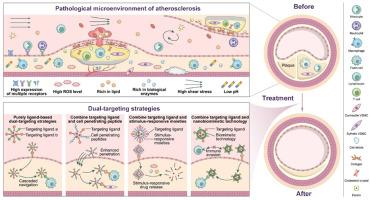Advancements in dual-targeting nanoparticle strategies for enhanced atherosclerosis therapy: Overcoming limitations of single-targeting approaches
IF 18
1区 医学
Q1 ENGINEERING, BIOMEDICAL
引用次数: 0
Abstract
Atherosclerosis treatment remains challenging, particularly in terms of developing effective targeted drug delivery strategies to enhance therapeutic efficacy. As research advances, considerable attention has been paid to identifying specific cell types and subcellular organelles—based on molecular mechanisms, damage progression, and drug action—to design next-generation nanoformulations with greater precision. Dual-targeting nanoparticles, which integrate numerous targeting modalities, offer a promising approach to precise drug delivery to pathological plaque sites. By enabling sequential and synchronous navigation of the targeting moieties, these strategies offer greater control over drug delivery than conventional methods. In this review, we discuss the pathological process of atherosclerosis and examine the progress made in its treatment using rationally designed nanoparticles over recent decades. We critically evaluate the limitations of single-targeting strategies and explore potential areas for improvement. Further, we provide a comprehensive overview of the classification and core principles of dual-targeting methods, thereby evaluating their efficiency. Finally, we discuss the design and application of strategies that integrate targeting ligands with stimulus-responsive moieties or nanobiomimetic techniques, thereby demonstrating their potential to address ligand-based dual-targeting nanotechnology limitations.

增强动脉粥样硬化治疗的双靶向纳米颗粒策略的进展:克服单靶向方法的局限性
动脉粥样硬化的治疗仍然具有挑战性,特别是在开发有效的靶向药物递送策略以提高治疗效果方面。随着研究的进展,人们越来越关注基于分子机制、损伤进展和药物作用来识别特定的细胞类型和亚细胞细胞器,以更精确地设计下一代纳米配方。双靶向纳米颗粒整合了多种靶向方式,为病理斑块部位的精确药物递送提供了一种很有前途的方法。通过实现靶向部分的顺序和同步导航,这些策略比传统方法提供了更好的药物递送控制。在这篇综述中,我们讨论了动脉粥样硬化的病理过程,并检查了近几十年来合理设计纳米颗粒治疗动脉粥样硬化的进展。我们批判性地评估单一靶向策略的局限性,并探索潜在的改进领域。此外,我们还全面概述了双靶向方法的分类和核心原理,从而评估了它们的效率。最后,我们讨论了将靶向配体与刺激响应部分或纳米仿生技术相结合的策略的设计和应用,从而展示了它们解决基于配体的双靶向纳米技术局限性的潜力。
本文章由计算机程序翻译,如有差异,请以英文原文为准。
求助全文
约1分钟内获得全文
求助全文
来源期刊

Bioactive Materials
Biochemistry, Genetics and Molecular Biology-Biotechnology
CiteScore
28.00
自引率
6.30%
发文量
436
审稿时长
20 days
期刊介绍:
Bioactive Materials is a peer-reviewed research publication that focuses on advancements in bioactive materials. The journal accepts research papers, reviews, and rapid communications in the field of next-generation biomaterials that interact with cells, tissues, and organs in various living organisms.
The primary goal of Bioactive Materials is to promote the science and engineering of biomaterials that exhibit adaptiveness to the biological environment. These materials are specifically designed to stimulate or direct appropriate cell and tissue responses or regulate interactions with microorganisms.
The journal covers a wide range of bioactive materials, including those that are engineered or designed in terms of their physical form (e.g. particulate, fiber), topology (e.g. porosity, surface roughness), or dimensions (ranging from macro to nano-scales). Contributions are sought from the following categories of bioactive materials:
Bioactive metals and alloys
Bioactive inorganics: ceramics, glasses, and carbon-based materials
Bioactive polymers and gels
Bioactive materials derived from natural sources
Bioactive composites
These materials find applications in human and veterinary medicine, such as implants, tissue engineering scaffolds, cell/drug/gene carriers, as well as imaging and sensing devices.
 求助内容:
求助内容: 应助结果提醒方式:
应助结果提醒方式:


